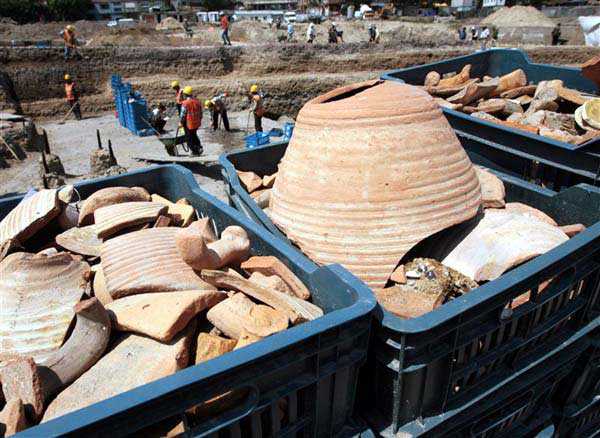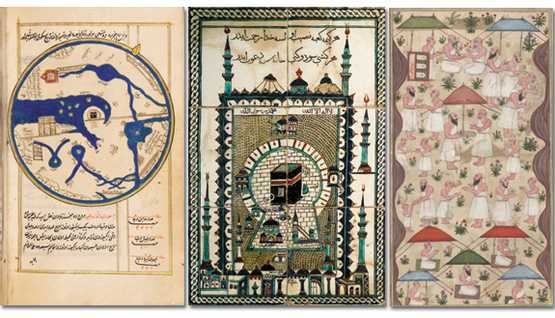One of the ways we finance our watery world travels aboard Wild Card is by cheaply acquiring rare & precious STUFF in exotic locations, and then reselling that stuff for mega-bucks in London, Paris, and the alleys of New Jersey. Only once has this buy-low, sell-high concept backfired—but how-the-heck was I to know the Mona Lisa wasn’t originally rendered in Crayon? Usually these art scams, antiquity frauds, and ‘indigenous’ swindles are highly profitable—or at least provide us enough pocket change to keep Wild Card limping westward.
Currently, we’re cruising the Greek isles, and have just made a major, major financial touchdown—the delicious details of which I will reveal in a moment.
But first, some current political history: Greece appears to be teetering on default within the Euro Zone. What does that mean? That means that a bunch of fat politicians in Brussels are pointing fingers of blame at each other, and screaming, “… it’s not my fault, it is de fault of de system!”
Here’s what really happened: the Brussels Posse were bored flying their black helicopters over France and Germany to air-lift out their profits, and so decided to loot Greece as well. This plan would have worked fine if Greece had had anything to loot—but they did not. Basically, they’d already looted their public treasury during the Golden Age, around BC400—and chopped off everyone’s head who complained. (Ah, the Good Ole Days!)
“Sure, we expected those naughty Greeks to ‘fudge the figures’ a tad,” said one outraged EC public servant, “but the Greeks outfoxed us by lying truly large.”
Yeah, you gotta admire the audacity of these truth-impaired Greeks. They are focused on the truly important aspects of life—like ouzo, anal sex, and international trickery—and refuse to be sidetracked by any silly, trendy ideas about public morality. Of course, we’ve known this for a long time. It’s not exactly a secret. After all, we don’t say, “Never trust an American bearing gifts,” do we?
Only the Greeks would have thought of having huge photogenic fields of movable, reusable plastic olive trees—easily transportable by truck—as photographic evidence to back up their nation-wide farm subsidy requests. Now that’s thinking out of the box! (Once satellite imagery confirmed the field’s existence to the EU agricultural experts, the fake plants were quickly moved to the next farm, and the process repeated.)
“And this is why we have our own alphabet,” quipped one fat, happy taverna owner, “so the stupid people we’re gyping don’t have a clue!”
Yes, the Greeks are far-sighted. Fleecing the tourists is encoded in their DNA.
“…let’s face it,” said one sailor from that large island in the south, “we’re Cretins and we know it!”
What’s all this got to do with Euro-cruising?
Once upon a time, long ago, there was a sailor like myself in the Med—a cruising yachtsman with delusions of grandeur who cruised with empty pockets and scribbled bizarre, rap-style notes about it. This early, trend-setting, ahead-of-his-time, water-borne gang-banger was dubbed Ughy by his crew (Hughie without the ‘h’ sound)—and, thus, chose Ulysses for his pen-name as his fame grew. It stuck. Ultimately, he made a mint on the TV rights to his ‘Odyssey’ brand—an early precursor to the Discovery Channel. Anyway, the media empire he spawned was very successful—mostly because he’d had the good sense to sprinkle in sex and violence about every third sentence. Picture Two-Pac if he’d jibed away from Thug Life and had, instead, joined the Athena’s Yacht Club—and you’re close to imagining this historically important figure—the sailing community’s first-and-still-most-famous marine journalist.
… of course, I don’t want to get too sidetracked by all this historical stuff. So let’s refocus solely on the modern day marine aspects of this story. For instance, the locals don’t refer to these islands as ‘Greece’ but rather as Hellenic—I assume because of the hellishly expensive chandlery prices.
In any event, there aren’t too many good harbors in the Aegean Sea. Most of the anchorages are too deep, gusty with the Meltemi winds, and have horrible holding. But this Ulysses dude was one tough marinaro. He toured the entire island chain over the course of ten eventful years of wild sex, random violence, and copious ouzo-gulping.
The problem was—and is—that wherever Ulysses tossed his anchor, a pricy stern-to Euro marina sprang up. That’s right—there is not a single square inch of water left in the Med suitable for anchoring which doesn’t cost, and cost big. Worse, you have to stern-to—and right in front of your very eyes (and, alas, your itching-to-be-off-the-boat cruising wife’s eyes) is an expensive Greek restaurant—so pricey they don’t waste time doing the dishes, they just break the plates and buy new ones. (I know, I know … it sounds unbelievable!)
… they don’t miss a trick, these entrepreneur Greeks. Upstairs of the taverna is the century-old whorehouse. Behind it (for the suddenly left-alone boat wifey) is a freshly-opened male strip club featuring the Full Monty. In between, are Vetus-kissed, Larzzara-blessed marine supplies stores with price-tags designed by Gucci.
Oh, these ‘full service’ marinas are exactly that. You don’t even have to move your boat if you want to take on fuel—the dockmaster will send over a dockboy pushing a 55 gallon pressurized drum—and pass you a hose. WHAM! …all the ouzo you can drink for as long as your American Express holds out.
No, Greece is not like Turkey—where the Islamic leaders frown on such profitable vices. A perfect example is all the lovely, lonely Orthodox Monasteries that dot the hillside—each with a huge parking lot for the tour buses, giant air-conditioned gift store, and ice cream huts everywhere. Even the religious toilet attendants reverently hand you complicated price-sheets, depending on need. (I just loudly shout, “Number One and Number Two—Means More Money for You!” to cover all the bases—in case I’m randomly spot-checked before the flush.)
“Don’t worry,” shouted one flush-faced reveler at the local sailor’s bar, “if we need another round of drinks, we’ll just charge it to Brussels!”
“… that’s right,” chimed in another, “we’ll just offer ‘em a higher interest rate—what’s the big deal when you’re not going to pay it back anyway?”
“Yeah,” gaily giggled another partier, “Why not make the Germans pay—they’re used to it!”
… even the near-by unsophisticated Turks are gaming the system. “Yes, we have a master plan to restore the Ottoman Empire,” they gloat evilly. “As soon as the current Greek administration takes down the European Community, we march out of Istanbul and …”
The point of all of the above is—when you sail into an expensive moral vacuum like Euro Land, well, it is easy to get your strict Calvinistic values turned around.
… which brings us full-circle.
The moment we went stern-to in Milos, in the Sick Ladies (spelled Cyclades), the dock vultures descended upon us. “Hey, skip! Wanna buy some water?”
“… how much?” I asked.
“Fifty Euro cents for diarrhea-inducing, and eight Euro per … for semi-clean!”
“… per metric ton?” I asked.
“…per liter!” he smirked back.
One guy tried to sell me a blue-swirled ‘evil eye.’ They are quite popular here. “Guaranteed to protect you from bad people,” he told me. I took it from him, and held it up to his face. He didn’t flinch or run away. “… this one is defective,” I told him as I handed it back.
An illegal African immigrant offered to sell me a blank DVD disk wrapped in a piece of paper with the name of a current movie freshly printed on it. I refused, saying, “How do I know you’re actually selling movies, when most street vendors aren’t?”
He looked wounded. “My guarantee as an honest movie pirate of high international integrity is a hundred percent!” he boasted. “If there is a problem, I’ll refund twice the amount paid!”
“… and where can I find you tomorrow?” I queried.
“Sudan,” he admitted. “But that’s not a problem—just ask any black man and he’ll refund your money!”
Yeah, right.
Mostly, of course, they attempted to sell me arms. Not arms-as-in-weapons but rather human-arms-made-of-marble …
Gee, I’m not doing a very good job of explaining this, am I?
This is the island where the famed Venus de Milo was discovered by Yorgos Kentrotas in 1820, sticking out of some dirt. In fact, the marble statue was such a nice piece of pornography that the French immediately attempted to cart it off to the Louvre. But the Greeks love a good ‘adult-toy’ too—and a little tug-of-war ensued as the eager Frogs were attempting to pilfer those perfect Greek breasts. And, of course, in the trans-cultural struggle, her arms snapped off and her nose was broken. Now, of course, if the damage had been done to her nipples or her buttocks, she’d have been worthless. But, luckily, nothing important was missing—and off she went to the Louvre, where she was soon ranked 8.7 in drool-a-bility. (Yes, this is how the world was—pre-internet-video.)
Of course, I was skeptical of the Greek lad attempting to sell me her arms—but he impressed me by offering to show me where he’d found them—and, after searching around in the bush a bit, I was amazed to learn that he was actually telling the truth. (By law, ‘truth-telling to a foreigner’ is currently illegal in Greece.)
This actually WAS where Venus had been found! So I gave him my money. Alas, I had thought that my 75 Euros would buy both arms—but discovered I hadn’t read the fine print. Thus, I only managed to purchase a single kilo from one arm—which he quickly broke off with a small sledge on-the-spot. Oh, well. At least I now have a True Euro Artifact that I can sell off for mega-bucks to fund our eventual retirement. Clever, huh? Yes, I love this Euro-Cruising!
(Editor’s note: Cap’n Fatty and Carolyn are now heading for Sicily, in hopes of finding a more honest, just society.)
Cap’n Fatty Goodlander lives aboard Wild Card with his wife Carolyn and cruises throughout the world. He is the author of Chasing the Horizon by American Paradise Publishing, Seadogs, Clowns and Gypsies, The Collected Fat, All At Sea Yarns, Red Sea Run and Somali Pirates and Cruising Sailors. For details and more, visit fattygoodlander.com






